Hamilton: Home of a Regiment
This is the first of our #WW2at75 series of blog posts, exploring stories from the Second World War on the 75th anniversary of the War’s end. In this post we’re going to look at the Regimental Depot of The Cameronians (Scottish Rifles) at Hamilton Barracks and its role during the War. We will also take a look at some of the regimental personalities who, for a time, called Hamilton ‘home’.
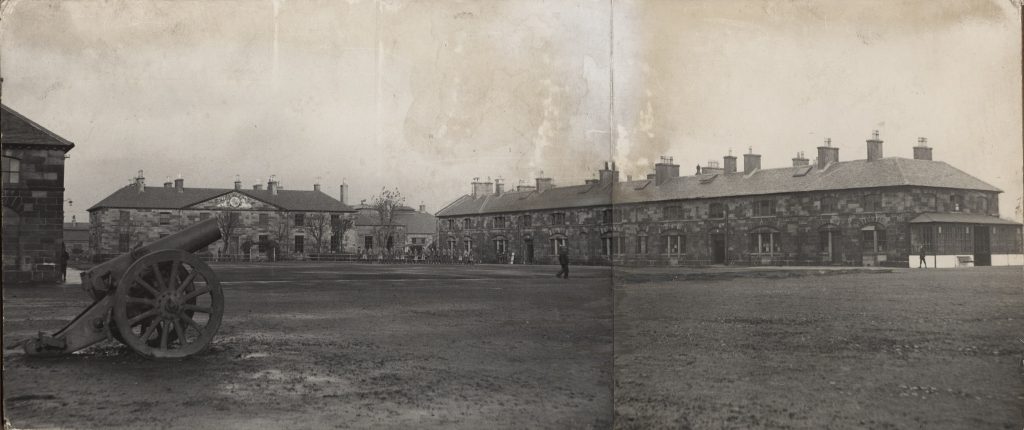
Many of The Cameronians’ wartime recruits would have passed through Hamilton at some point during the Second World War. Hamilton Barracks had been home to The Cameronians (Scottish Rifles) Regimental Depot since 1881[i]. Shortly after War broke out in late 1939, an Infantry Training Centre (ITC) was established in Hamilton and took over much of the training responsibilities from the Depot. In August 1941, the ITC moved to Aberdeen and was reconstituted as No. 9 Infantry Training Centre; Regimental Headquarters remaining with the Depot in Hamilton.
Hamilton Barracks were built in 1795 as a cavalry barracks, originally with space to accommodate 170 soldiers and 189 horses[ii]. The ground floor of the barrack buildings provided stabling for a regiment’s horses, with soldiers’ accommodation located above. By the 1850s the barracks were shared by a mix of cavalry and infantry units and were also headquarters of local militia regiment, the Royal Lanark Militia. The cavalry finally left the barracks in 1877 to go to Maryhill Barracks in Glasgow, after which Hamilton was left solely as an infantry barracks.
The barracks in Hamilton occupied a long, narrow strip of land running parallel to Bothwell Road from (what is now) Almada Street to just beyond (what is now) Caird Street. When built in the 1790s, the barracks were outside the centre of town, in a fairly rural area but with good road (and later rail) links to Glasgow and Lanark.

In 1881, Hamilton Barracks became home of the regimental depots of The Cameronians (Scottish Rifles) and the Highland Light Infantry (HLI); shortly after the First World War, the HLI depot moved to Glasgow leaving The Cameronians as sole occupants. The Regimental Depot was home to a permanent staff of Officers, Non-Commissioned-Officers and trained men, responsible for the training of new recruits. The Depot was also home to the soldiers’ Married Quarters, where the families of men on the Married Establishment (i.e. those who had married with their Commanding Officer’s permission) resided while their husband served overseas.
In the years preceding the Second World War, soldiers joining The Cameronians (Scottish Rifles) would initially join the Regimental Depot where they would receive their recruits training over a period of roughly 18 weeks. On completion of this training they were generally posted to whichever Regular Battalion of the Regiment was on Home Service; this Battalion was then responsible for sending reinforcing drafts, as required, to the other Regular Battalion, usually stationed overseas.

In July 1939, shortly before the outbreak of war, a new batch of recruits arrived at Hamilton Barracks; these were the Militiamen – who would in fact become Britain’s first conscripts of the Second World War. This new ‘Militia’ was raised in 1939 in the face of growing tensions with Nazi Germany; the idea being to create a pool of trained men to call on in an emergency by giving all men between 20 and 22 years of age six months of military training before returning them to civilian life. With the outbreak of War in September the Militia scheme was abandoned and conscription introduced.
With Britain’s entry into the War came the need to train recruits on a scale not seen since the First World War. As such, an Infantry Training Centre (ITC) was established at Hamilton Barracks to help mould and shape this new influx of raw recruits into trained soldiers. The ITC quickly spilled over to Hamilton Racecourse where tented accommodation and training facilities were established. Officers posted to the Infantry Training Centre were either housed in the Officers’ Mess, or billeted in private residences throughout the town and beyond. A number of officers who lived locally were able to return home each night following training. One such officer who found himself in this fortunate position was Martin Ferrey, who lived in Burnside with his wife, Mary:
I was delighted to find that the war was conducted in proper British fashion at the Depot from 9 a.m. to 5 p.m. and I was always able to catch the 5.15 bus home after the last parade had finished and furthermore sleeping out passes were readily available, but not I discovered on Thursday evenings which were decreed as “Mess Nights” when all officers had to dine in, a rule introduced by the Commanding Officer, who, as his home was in High Wycombe was the only one of us unable to spend the evening with his wife and children & I suppose felt lonely dining each night with only the Duty Officer to keep him company.[iii]
Thousands of men passed through the Infantry Training Centre in Hamilton for their military induction and training before being posted to a Cameronian battalion, either in the UK or overseas.

Recruits’ training focused primarily on drill and weapons training, where men were introduced to the tools of their trade, such as the .303 Lee Enfield rifle, the Bren light machine gun, and the anti-tank rifle. Regular route marches through the town and surrounding area helped raise general fitness and also condition the recruits’ feet to long marches in army-issue boots. Early recruits were identifiable by the distinctly un-Scottish forage cap; the Glengarry being the reserve of the trained soldier, officer and instructor. This rule was later relaxed (and due in no small part to increased availability of uniform and kit) and subsequently all recruits were issued with a Tam O’Shanter cap on arrival.
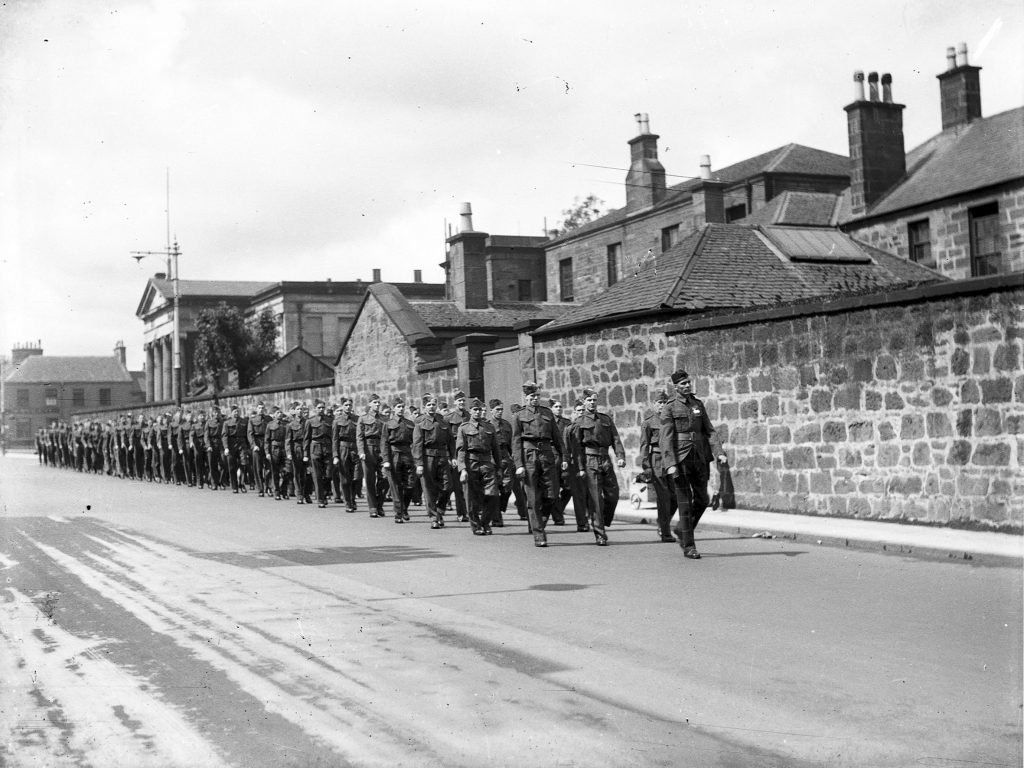
A typical day for the recruits involved Reveille (wake-up by bugle call) at 6:30am, breakfast at 7:15am, Parade at 8:30am, and then drill, training, kit cleaning etc., until 4:30pm. Although the day’s training was hard, recruits were able to make the most of their free time during the evenings and their one ‘day off’ a week. The Barracks in Hamilton had it’s own NAAFI (Navy, Army, and Air Force Institutes) canteen and a YMCA (Young Men’s Christian Association) hut where both organised and improptu entertainment could be found in the manner of shows, plays, sing songs etc. After a few weeks of initial training, when the recruits were considered to be of a suitably soldier-like appearance, they were allowed out of Barracks to sample what Hamilton had to offer:
There is not much to do except the Pictures; I hope to get out some time this week to see the ‘Thief of Bagdad’. There are 3 picture houses in the town, the Odeon, Regal, and a bug-hutch, it is a proper Barracks Town with plenty of local talent around the Barrack entrance…[iv]
There was even time to soak up some of the local culture, by way of organised visits to local attractions such as Hamilton Mausoleum:
Having thoroughly explored the wonders of the interior, our guide conducted us outside to the front of the building. I, for one, had admired the lions on their pedestals and the three carved heads several times before, but had never had them explained to me… The three human heads represent Life, Death, and Immortality. Life has a sad and worried look, Death looks very peaceful, but the most striking thing about the whole three is the expression in the eyes of Immortality. The eyes are open, a very unusual thing in a carving of stone, and they are marvelously alive. They seem to look into the distance over one’s head and to see something far beyond human vision. The expression is one of calm happiness. I shall certainly remember that look when I have forgotten even the echo of the Mausoleum.[v]
In August 1941, the Infantry Training Centre at Hamilton was moved to Aberdeen. There it was reformed as the No. 9 Infantry Training Centre along with the Highland Light Infantry, and the Gordon Highlanders. With the onus of the training of the Regiment’s recruits moved elsewhere, life at Hamilton Barracks calmed somewhat. By the mid-1940s many of the buildings in the Barracks had been condemned as a result of subsidence caused by coal mining. Indeed, the handsome Officers’ Mess building had already succumbed to this in 1934. The Mess building was demolished and the Royal Arms of George III, which had graced the portico facade since it was built, was moved to the Sergeant’s Mess building on the east side of the barrack square.
Although the steady stream of recruits had dwindled at Hamilton from late 1941 onwards, the Barracks was still home for the remainder of the War to the Regimental Depot Party, the Regimental Museum (which first opened in the Barracks in 1931), headquarters for various local Home Guard units, and to units of the ATS (Auxiliary Territorial Service – the Women’s branch of the Army during Wartime).
The Regimental Depot Party, under the command of Major Donald Grant since early 1940, was responsible for the every-day admin of the Regiment, including the storage of regimental property, regimental finances, the regimental association, and the production and distribution of the regimental magazine, The Covenanter. The Depot Party were inundated with requests for information on officers and men who had been reported missing in action. As a result Major Grant and his small staff were in constant correspondence with officers in the various battalions of the Regiment on active service across the globe in an effort to keep tabs on the comings and goings of personnel and keep worried families furnished with news of their loved ones. The Regimental Comforts and Prisoners of War Funds were also run and administered from Hamilton Barracks, under the careful guidance of Mrs Irene Grant (wife of Major Grant) and Mrs V. C. Sandilands (wife of another senior Cameronian officer).
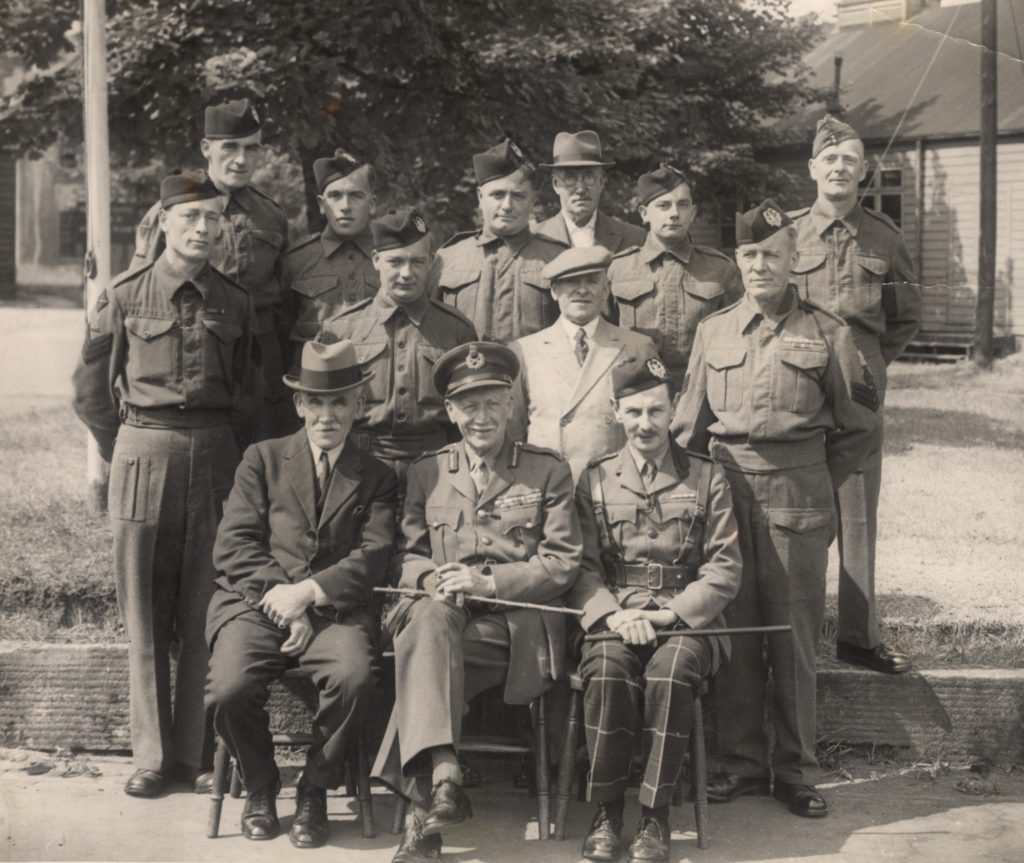
Back Row: Rfm. Black, Rfm. McBride, Rfm. Geoghan, MM., Mr. R. Thomson, Rfm. Towler, Pte. Cooper.
Middle Row: Sgt. Pincett, Rfm. Flemming, Mr. W. Poppleton, C/Sgt. Ahlers.
Front Row: Lt. Col. Lindsay, Major-General Sir Eric Girdwood, Major D. C. Grant. ©SLC
In his farewell letter to the Regiment on the end of his tenure as Colonel of the Regiment, Major-General Sir Eric Girdwood wrote:
There are so many people to whom, not only my personal thanks, but the thanks of the whole Regiment, are due, that it would require a special edition of “The Covenanter” if I were to name them all. Chief, however, amongst these are Mrs. Donald Grant, who as Hon. Secretary of The Cameronians Comforts and Prisoners of War Funds, who from their inception has never for one moment relaxed her efforts – not even when mourning the death in action of her only son [vi] – on behalf of the Regiment. Without her inspiring self-sacrifice and willing and cheerful work the successful issue of these activities could never have been achieved.
To Mrs. V. C. Sandilands for her splendid handling of our P.O.W. parcel service throughout all these long weary years of war to which the grateful letters of the recipients bear far better testimony than any poor words of mine. To both these ladies we all owe a debt of gratitude that we can never hope to repay.
To Major Donald Grant I can only say a very big “Thank You”. I do not speak of his excellent work as Depot Party Commander – that is for others to do. I speak of the hundred and one other matters, far outside his ordinary military duties, the burden of which invariably fell on his already overburdened shoulders, but never once in all the past 6 years did he fail me or anyone in the Regiment who sought his willing help. I know that every C.O. when he wanted anything at once appealed to “Donald.” His one and only thought has been throughout these years of endurance – “The Regiment.”
To my old and trusty friend, Lt.-Col. J. F. Lindsay, M.B.E., who has perhaps done more for the individual Cameronian than any man I know. With his age and service many would have been content to rest on their laurels. Not so he. Out and about at all hours of the day and night, traveling great distances in the extreme discomfort of wartime transport and the most inclement weather – nothing daunted him, his only incentive “Service” to the Regiment.
To both these officers I am so deeply indebted that I can find no words in which I can adequately express my gratitude for their help, sympathy and encouragement at all times.
And last but not least to that faithful little “Band of Brothers” – The Regimental Depot Party – Mr. Dunn, our able, willing and cheerful Bandmaster – to C.Q.M.S Ahlers, Mr. Poppleton and Mr. Thomson whose team work pulled us through all our difficulties. I can only say to these unsung heroes that they pulled their weight nobly and have earned the gratitude and the esteem of the whole Regiment.
Once more I thank you all from the bottom of my heart. Goodbye. Good luck and God bless you all.[vii]
So, what then ultimately became of Hamilton Barracks and the Regimental Depot of The Cameronians?
The previously mentioned subsidence problems along with the overall age, condition and maintenance costs of Hamilton Barracks had led to the decision to remove The Cameronians (Scottish Rifles) from Hamilton in the mid-1930s. New barracks were in the process of being built at Lanark when the outbreak of War put the Regiment’s move on hold. It wasn’t until 1947 that the Regiment would occupy its new Home at Lanark’s Winston Barracks.
Hamilton Barracks survived for several years after the Second World War, and was home to Territorial Reserve units of the Royal Army Service Corps, Royal Army Medical Corps, Royal Electrical and Mechanical Engineers, and a unit of the Army Cadet Force and Air Training Corps. The aging buildings were finally demolished and, by the early 1970s, another multi-story building would soon grace the Hamilton skyline in the form of Bell College of Technology.
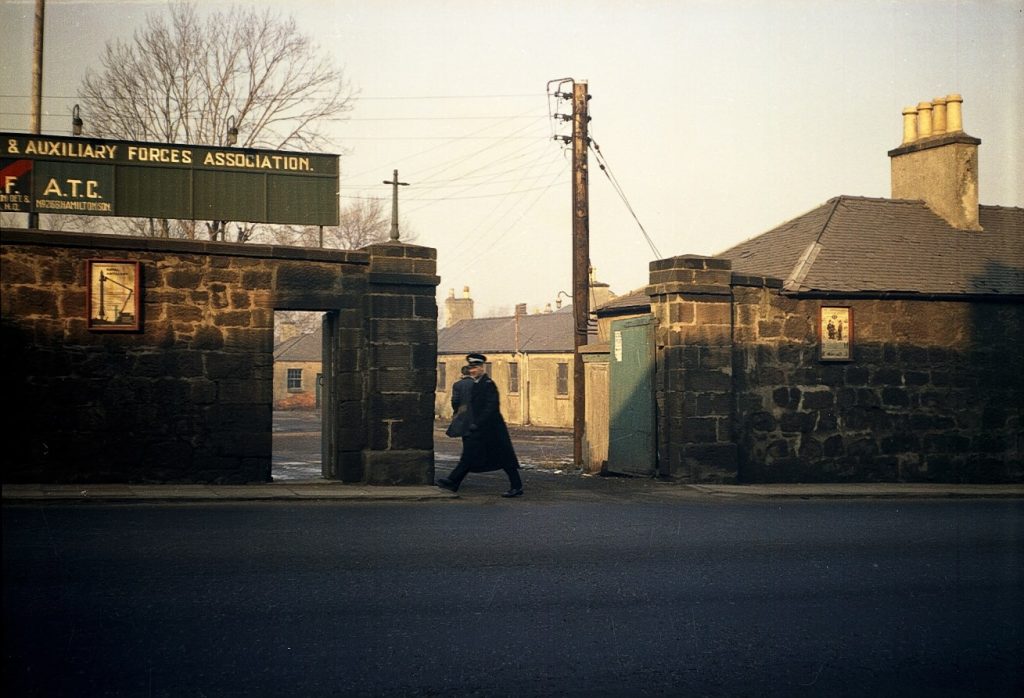
Today, much of the site of the Barracks is occupied by the (recently vacated) University of the West of Scotland. The only physical reminder that the Barracks ever existed on the site are the surviving sections of the original boundary wall and the Army Reserve and Cadet centre on Bothwell Road. With the recent move of the University to a new campus elsewhere in Hamilton the site is scheduled for future redevelopment.
It is a sobering thought to consider that many of the 1,222 men of The Cameronians (Scottish Rifles) who died in service during the Second World War would, at some point, have passed through the Regiment’s home town of Hamilton.
The Cameronians (Scottish Rifles) connection with Hamilton is preserved through the Regimental Museum collection, housed within Low Parks Museum, just a few hundred yards east of where Hamilton Barracks – the Regiment’s home for the best part of a century – once stood.
[i] One of The Cameronians (Scottish Rifles) antecedent regiments, the 90th (Perthshire) Light Infantry, had its depot at Hamilton Barracks prior to its 1881 amalgamation with the 26th Cameronian Regiment.
[ii] One of the first units based in Hamilton Barracks was the Norfolk Regiment of Fencible Cavalry, who were stationed in the town in the late 1790s.
[iii] Ferrey, M. Unpublished MS in Museum Collection (CAM.G140)
[iv] Letter from Rifleman Wallis, April 1941. Private collection, courtesy of Mr Steven Brown
[v] “Impressions of the Mauseleum [sic]” by Private J. G. MacPherson. The Covenanter, September 1941
[vi] Major and Mrs Grant’s son, Geoffrey, was killed during the War. He was a Glider Pilot in the Royal Air Force Volunteer Reserve and was killed on operations in March 1945. Geoffrey and his wife, Barbara, had lived in Stonehouse.
[vii] Farewell Letter from the Colonel of the Regiment. The Covenanter, January 1946.
Comments: 10
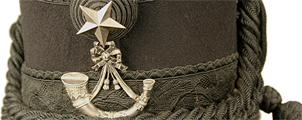
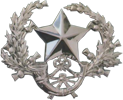

This is excellent Barrie. The work involved in creating this post must be enormous. I wish you great fortune in your endeavours for the next one.
Kindest Regards,
Tom Lang.
Thank you Tom, I appreciate your kind words. The Barracks is a fascinating place to research; I think I have enough material left over for a revisit at some point down the line!
All the best, Barrie
Would like some information my grand father was Sargent mayor when he left army john William’s my father Richard William’s also served with cameronions and some other brothers
Thank you for your comments Evelyn. Do you happen to have some rough dates for when John and Richard Williams might have served? Why not fill in our enquiry form with all the information you have and we’ll see what we have that might help you in your research – https://www.sllccameronians.co.uk/feedback.
Thanks, Barrie
Very interesting info about the Barracks at Hamilton. I lived in Montrose Cres, just off Almada St as a child (60’s)and remember the abandoned buildings were we used to explore as kids although it was in a dangerous state by then. Thank you for the History lesson I really enjoyed reading this history,
Thank you for your kind comments, Valerie; I’m very glad that you found the post interesting. The child in me could only imagine the excitement of exploring the empty barrack buildings, while the parent in me shudders at the thought! Thanks again, Barrie
A very informative and interesting read!
Thank you Margaret, I’m glad you enjoyed it.
In 2005 I wrote a pamphlet to accompany that year’s issue of The Covenanter, the regimental magazine and newsletter of The Cameronians (Scottish Rifles). Its title was ‘The [Cameronian] Generals’. Here is a short extract:
‘There was another vital appointment and we return now to the role of the father of the Regiment. The Cameronians (Scottish Rifles) were particularly fortunate in the appointment in 1927 of a new Colonel of the Regiment who was to serve right through until handing over to [General Sir Thomas] Riddell-Webster in 1946 – an astonishingly long tenure, even allowing for six years of war. He was Major General Sir Eric Girdwood KBE CB CMG. According to Story [author of Volume II of the Regimental History]: ‘It was his policy to knit the Regiment more closely together than ever …’ To achieve this, amongst other things, he instituted the Regimental Committee: ‘… the purpose of which is to manage the affairs of the Regiment which are outside the scope of Battalion Commanders or the officer commanding the Depot …’. His influence in the selection of commanding officers should not be overlooked either.
Girdwood was a Captain in 1914 and by the following year, still a Captain, he was a Brigade Major in France. By 1917, though still only a substantive Major, he had risen to the rank of Major General. He commanded the 74th Division at the Third Battle of Gaza that year. ‘The extraordinary speed of its advance had an immediate effect at Gaza, since the enemy had to withdraw and conform to a general retirement everywhere.’ It was this breadth of experience which was to stand him in such good stead and which had such a great and positive effect on the Regiment as a whole.
His appointment as Colonel coincided with that as Commandant of the RMC Sandhurst (1927-30). It was during Girdwood’s time at Sandhurst that Frost and Alexander [both later to rise to become Major Generals] were recruited to the Regiment. His last appointment was as GOC Northern Ireland. In 1937, for the Coronation of King George VI, he was appointed Gold Stick Staff Officer and as such had responsibility for all of the seating arrangements in Westminster Abbey. Notwithstanding all of his other duties, in war as in peace-time, he was assiduous in his attention to the welfare of ‘his’ Regiment: a true ‘father’. It was typical that he was on the quayside at Southampton when the 2nd Battalion sailed home from the Middle East on 30 December 1936.
Brigadier CN Barclay [author of Volume III of the Regimental History] describes in detail the work over which Girdwood presided:
‘Apart from its more concrete peace-time activities – such as the Regimental Association and the Regimental Journal [The Covenanter] – the Regimental Committee had a very notable influence for good in what may be termed the more intangible affairs of the Regiment. In particular it exercised a marked, if indirect, influence on officers’ careers. It became a feature of Regimental policy to encourage young officers to enter one of the staff colleges, and to apply for attachment to Colonial forces – such as the King’s African Rifles and the West African Frontier Force.’
Girdwood’s successors as Colonels of the Regiment were:
1946 – General Sir Thomas Riddell-Webster GCB DSO
1951 – General Sir Richard O’Connor GCB DSO MC (and later KT as well)
1954 – Major General Douglas Graham CB CBE DSO MC
1959 – General Sir Horatius Murray GCB KBE DSO
1964 – Lieutenant General Sir George Collingwood KBE CB DSO
1968 – Major General Henry Alexander CB CBE DSO
1973 – Brigadier David Riddell-Webster OBE
Thanks, Philip, for such a detailed and informative response. Girdwood is indeed a fascinating figure, particularly as Colonel of the Regiment. Reading through the wartime editions of The Covenanter, it is evident that his efforts to knit the Regiment more closely together were not in vain.